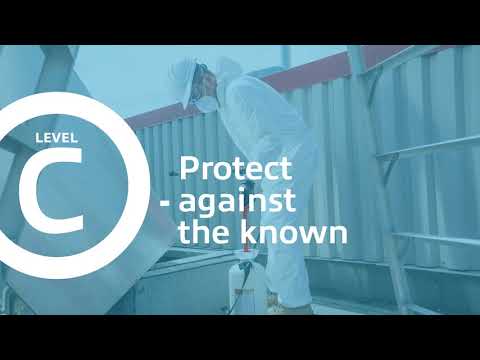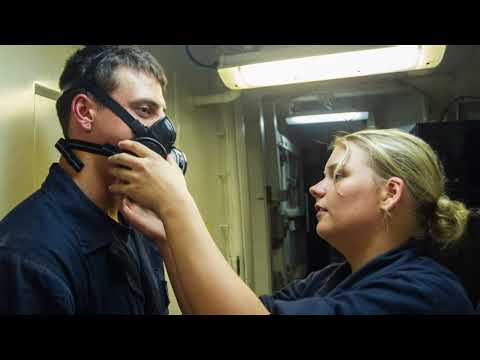How to Avoid OSHA’s Top Safety Violations in General Industry
OSHA’s annual list of most-cited violations can help companies in general industry avoid becoming a costly citation statistic.
OSHA’s annual list of most-cited violations can help companies in general industry avoid becoming a costly citation statistic.
Every year, OSHA publishes a list of the Top 10 violations. Many of them deal with the construction industry. For this article, we take a close look at the 2018 violations that most apply to “general industry,” which include: hazard communication, respiratory protection, lockout/tagout procedures, machine guarding and powered industrial trucks.
As detailed by associate editor Kevin Druley in Safety and Health magazine, in 2018, Nox US LLC in Ohio was fined $514,236 for five willful and two serious violations, including violations of lockout/tagout standards. Douglas Stephen Plastics Inc. in New Jersey was fined $435,679 for serious, willful and other-than-serious violations, including violations related to machine guarding and personal protective equipment standards.
Beyond the financial cost, failing to comply with OSHA regulations can endanger employees. The Nox US LLC fines came after one worker’s hand was crushed and another lost part of two fingers.
How can manufacturing companies avoid becoming one of the statistics released each year when OSHA announces its list of top 10 violations? Here are a few suggestions for violations of the general industry standards that are on the list:
The OSHA hazard communication standard (CFR 1910.1200) is designed to protect workers from chemical hazards in the workplace. In 2018, there were a total of 4,537 violations.
What Goes Wrong
The most common citations were for failure to develop, implement and maintain a written hazard communication program (1910.1200(e)(1)) with 1,510 violations; failure to provide employees with information and training on hazardous chemicals in the workplace (1910.1200(h)(1)) with 1,167 violations; and failure to maintain safety data sheets for all hazardous chemicals (1910.1200(g)(8)) with 496 violations.
Are your hazard communications current? Read how to catch up.
What to Do
OSHA provides several resources to help employers develop hazard communications. These include a fact sheet, guidelines for compliance and a sample hazard communication program. In an article for Industrial Safety & Hygiene News, Greg Duncan offers six steps for implementing an effective program and avoiding costly fines.
“Approaching your HCS program as an ongoing responsibility, rather than just a one-time requirement, helps prevent you from becoming just another citation statistic on the agency’s list of top violations,” Duncan writes.

OSHA Standard CFR 1910.134 requires employers to protect workers from harmful dusts, fogs, fumes, mists, gases, smokes, sprays or vapors. There were a total of 3,112 violations in 2018.
What Goes Wrong
The most common citations were for failure to provide a medical evaluation to determine an employee’s ability to use a respirator (1910.134(e)(1)), 583 violations); failure to have a written respiratory protection program with worksite-specific procedures (1910.134(c)(1)) with 450 violations; and failure to fit-test tight-fitting respirator faceplates (1910.134(f)(2)) with 276 violations.
What to Do
OSHA offers a variety of guidance on its website, including a booklet on respiratory protection and links to videos and other resources. The Center for the Polyurethanes Industry of the American Chemistry Council also offers an online guide for developing a written respiratory program, and the 3M Center for Respiratory Protection provides a summary of the key steps in meeting OSHA guidelines—from exposure assessment to training.
Frustrated by all the respirator options? Don’t fear. Read our guide: “PPE Selection: Find the Right Type of Respirator.”

OSHA Standard CFR 1910.147 requires employers to protect workers from the unexpected energization or startup of machinery that is being serviced or maintained. There were a total of 2,923 violations in 2018.
What Goes Wrong
The top violations cited were for failure to develop, document and use lockout/tagout procedures (1910.147(c)(4)(i)) with 587 violations; failure to inspect the energy control procedure at least annually to make sure it’s being followed (1910.147(c)(6)(i)) with 342 violations; and failure to establish an energy control program (1910.147(c)(1)) with 332 violations.
Struggling with your lockout/tagout needs? Use our interactive product selector to find the right LOTO kit by the type of energy your plant uses.
What to Do
OSHA provides a simple lockout procedure for employers to use as a basis for developing their own procedures. The agency also offers a variety of other information and resources for the control of hazardous energy. In an article for ESC Services, Kyle Pulsipher suggests using a digital system to maintain and organize procedures for different pieces of machinery.
“Using file names with the location, area, equipment name, and equipment number if applicable will make it simple to find any procedure within the company,” he says. “These files can be uploaded to a cloud server to make them available to any personnel needing access, and preventing the files from being lost.”

OSHA standard CFR 1910.212 covers general machine guarding requirements for all machines, requiring employers to protect machine operators and other workers from hazards such as nip points, rotating parts, flying chips and sparks. There were a total of 1,969 violations in 2018.
What Goes Wrong
The most common violations were for failure to provide a method of machine guarding (1910.212(a)(1)) with 1,289 violations; failure to use guards that meet applicable standards at the point of operation (1910.212(a)(3)(ii)) with 475 violations; and failure to securely anchor machines designed for a fixed location (1910.212(b)) with 76 violations.
What to Do
OSHA’s e-tool helps employers recognize and control common amputation hazards in the workplace. The Environment, Health & Safety program at the University of California Berkeley offers a detailed guide on machine guarding, including hazard point types and FAQs. Still don’t know where guards are needed? In an article in Safety & Health magazine, David W. Kerr, a consultant for Airline Hydraulics Corp., says conducting a hazard analysis is the first step.
“This step is critical to ensure a safe and compliant solution that won’t negatively affect production, productivity or quality requirements,” Kerr says. “If your employer doesn’t have personnel with the technical capabilities to conduct the hazard analysis, an external partner may be required.”
OSHA standard CFR 1910.178 covers the design, maintenance and operation of powered industrial trucks, including forklifts, lift trucks and motorized hand trucks. There were a total of 2,281 violations.
What Goes Wrong
The most common violations were for failure to ensure each powered truck operator is competent (1910.178(I)(1)(i)) with 417 violations; failure to evaluate each operator’s performance at least once every three years (1910.178(I)(4)(iii)) with 263 violations; and failure to certify that each operator has been trained and evaluated (1910.178(I)(6)) with 258 violations.
What to Do
According to an article in EHS Today, 70 percent of forklift accidents in the U.S. could be prevented with proper training. Powered industrial truck manufacturers and dealers, such as MCF, Illinois Material Handling, and Wisconsin Lift Truck Co., may offer training. The Industrial Truck Association, which sponsors National Forklift Safety Day, helped OSHA to develop sample daily checklists for truck operators to use to inspect and maintain their trucks.
All training must be site-specific, writes DC Velocity contributing editor Toby Gooley in a National Forklift Safety Day article.
“It’s important to remember that forklift certification is NOT portable,” J. Scott Bicksler, lead safety manager for Aerotek Inc., a global recruiting and staffing agency, told Gooley. “The policies, procedures and processes may be totally different from company to company, and they may have totally different forklifts.”
The Penalties Inflation Adjustment Act Improvements Act of 2015 requires the Occupational Safety and Health Administration (OSHA) and other Department of Labor agencies to increase their penalties each year. As of Jan. 23 of this year, OSHA penalties are:
$9,472: Willful violations, minimum
$13,260: Serious violations, other-than-serious violations, failure to correct violations and posting requirement violations
$132,598: Willful violations, maximum; and repeated violations
OSHA’s biggest proposed fine in 2018 was to Didion Milling, a grain milling facility in Wisconsin, which was charged with 14 willful violations and five serious violations. Five workers died and 12 were injured at the facility after an explosion caused by the company’s failure to address hazards.




